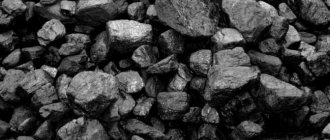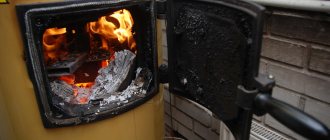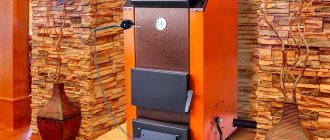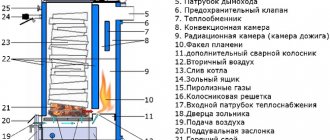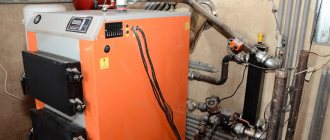If there is no gas pipeline near you, and you do not want to carry gas in cylinders or use electricity to heat your home because of its high cost, then you can use coal for heating - an old and proven way to heat a house over the years. Despite the fact that this type of heating is considered classic and almost ancient, in modern times the equipment for this is already high-quality and created using the latest technologies.
Probably everyone is familiar with the image of a typical Russian brick stove, and now, using coal for heating, the system will work on the same principle. However, there is a significant difference: the room is heated by coal boilers not due to the heat from the flame, but due to the heating of the water heat carrier, which is driven by a pump to the radiators.
Coal for heating
How and what kind of coal is best to heat a solid fuel boiler
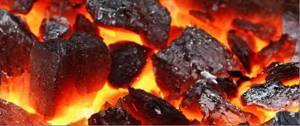
Several grades of hard and brown coal are usually offered for household consumption; in addition, charcoal is also used. But, before loading the firebox with new fuel, you must carefully read the instructions for using the solid fuel boiler; it contains the brands of fuel recommended by the manufacturer.
For domestic and industrial heating boilers, the documentation indicates the optimal grades of coal for use. The fact is that during the production of boilers, finished products are tested and certified for use with different types of fuel. The heat capacity of coal of one group may be higher than the heat capacity of the brands recommended by the manufacturer, which is why the normal operation of the equipment may be at risk.
One of the conditions for how to properly fire a boiler with coal is the correct choice of fuel; in addition to indicating the type and brand, manufacturers recommend focusing on the amount of harmful impurities, dust, ash content and calorific value. This information is indicated in the fuel passport, but what specific qualities a particular brand has is worth finding out in more detail.
Coal
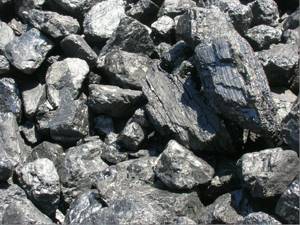
This type of coal is the most common. In most brands, the calorific value averages about 5500-6000 kcal/kg. This indicator is associated with a high hydrocarbon content; this substance makes up about 75% of the mass. When burned, coal produces from 2 to 5% ash, but it is worth saying that this applies to a high-quality product that has been cleaned from rock. Coal grades are divided by fraction size, weight and calorific value. In addition, there is a gradation based on how quickly the fuel burns. Almost all grades of coal are suitable for firing universal solid fuel boilers of the classic type. But such fuel is not suitable for long-burning devices; it has a rather high temperature index, which has a detrimental effect on the equipment.
Brown coal

This fuel is mainly used in the areas where it is mined. It so happened historically that brown coals were not widely used and are mainly a product of local consumption. The calorific value of brown coal is lower than that of hard coal, it is approximately 3000-3200 kcal/kg, this figure is almost 2 times lower than that of the lowest grade of hard coal. A special feature of this product is that after combustion it leaves more ash. In domestic heating installations, brown coal is used, and briquettes made from it with a mass fraction of humidity of about 50%.
Anthracite
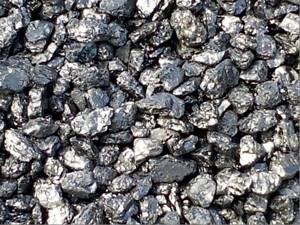
When choosing a fuel with the highest calorific value, you should focus on anthracite, one of the best types of coal for combustion in a boiler. The calorific value allows the release of 9000 kcal/kg during combustion, which is one of the highest values. However, after combustion, anthracite forms a large amount of ash, up to 7%, and up to 5-7% of coal that is not burned.
Lignite
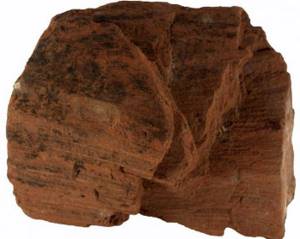
This type of coal raw material is intended for consumption in industrial installations. Many manufacturers do not recommend using it in everyday life due to its specific structure and large amount of ash residue.
Coal processing products
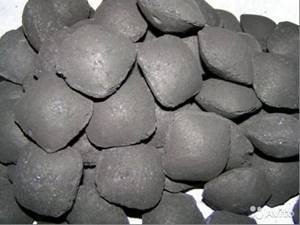
Conventionally, these types of products are difficult to attribute to any type of solid fuel made from natural hydrocarbons, but it is also quite difficult to ignore them. This type of product includes coal processing products - coal briquettes and coke.
The first is a briquetted type of fuel obtained by pressing waste from coal recovery at processing plants. Simply put, this is a pressed fine fraction of graded coal that remains after sifting the main mass. Such fuel is mainly used in industrial enterprises, since during combustion it releases a large amount of sulfur, and the ash content in the residue often exceeds 10% of the initial mass.
Coal dust in its pure form is practically not used in individual heating systems, since the technology of burning dust in solid fuel household boilers is not provided. In industrial production, in the energy sector with thermal generation and even in metallurgy, the use of dust is justified; it, in the form of a water-dust mixture, competitively replaces expensive natural gas, but in small boilers designed for 7-15 kW of power, this method is too expensive.
Coking coal, which is the main fuel for blast furnace production of pig iron, can be successfully used at home. However, you need to remember that the energy value ranges from 5.6 to 7.0 thousand kcal/kg. The average ash content is about 8%, volatile substances from 3.2 to 4.2%, sulfur in coke is 1-2%. Pure carbon makes up at least 87% of the substance.
Gas coal
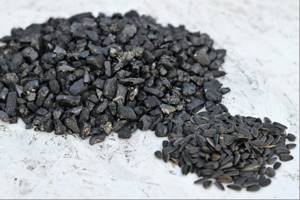
This type of coal is often called flammable coal in everyday life. Saturated with light flammable gases, coal of this group has a small fraction, only 3, maximum 4 cm in diameter. This product is excellent for kindling, because it quickly begins to maintain combustion and also quickly raises the combustion temperature to 400-600 degrees, which is quite enough to ignite the bulk of the main fuel coals. But it’s unlikely to be used for a full-fledged combustion chamber; its calorific value is low, and the combustion time is 4-5 times higher than that of anthracite or coke.
Charcoal
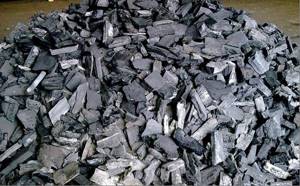
Until the recent past, charcoal was one of the most common coal products. Today this coal has given way to hard coal, but it still remains in demand in private households. When burned, it produces from 7000 to 8000 kcal/kg, which is a good indicator compared to ordinary firewood. After combustion of 84% carbon, 2 to 2.8% ash is formed. It is especially good to use charcoal in solid fuel pyrolysis boilers and long-burning boilers.
Ignition temperature and other parameters
The process of coal combustion is a chemical reaction of carbon oxidation that occurs at a high initial temperature with intense heat release. Now it’s simpler: coal fuel cannot ignite like paper; ignition requires preheating to 370-700 ° C, depending on the type of fuel.
Key moment. The efficiency of coal combustion in a stove or household solid fuel boiler is characterized not by the maximum temperature, but by the completeness of combustion. Each carbon molecule combines with two oxygen particles in the air to form carbon dioxide CO2. The process is reflected in the chemical formula.
If you limit the amount of incoming oxygen (cover the ashpit, switch the TT boiler to smoldering mode), instead of CO2, flammable carbon dioxide CO is formed, which is emitted into the chimney, and the combustion efficiency will significantly decrease. To achieve high efficiency, you need to provide favorable conditions:
- Brown coals ignite at a temperature of +370 °C, hard coals - 470 °C, anthracite - 700 degrees. Pre-heating of the heating unit using firewood (sawdust briquettes) is required.
- Air is supplied to the firebox in excess, the safety factor is 1.3-1.5.
- Combustion is maintained by the high temperature of the hot layer of coals lying on the grate. It is important to ensure the passage of oxygen through the entire thickness of the fuel, since air moves through the ash pan due to natural chimney draft.
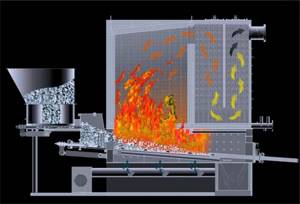
Comment. The exceptions are homemade stoves of the “Bubafonya” type and cylindrical top-burning boilers, where air is supplied to the firebox from top to bottom.
The theoretical combustion temperature and specific heat transfer of various types of fuel are shown in the comparison table. It is noticeable that under ideal conditions any fuel will release maximum heat when interacting with the required volume of air.

In practice, it is unrealistic to create such conditions, so air is supplied with some excess. The actual combustion temperature of brown coals in a conventional TT boiler lies in the range of 700...800 °C, of rocks and anthracites - 800...1100 degrees.
If you overdo it with the amount of oxygen, energy will begin to be spent on heating the air and simply fly out into the chimney, the efficiency of the furnace will noticeably drop. Moreover, the fire temperature can reach 1500 °C. The process resembles a regular fire - the flame is large, there is little heat. An example of efficient combustion of coal with a retort burner on an automatic boiler is presented in the video:
How to heat a boiler from theory to practice
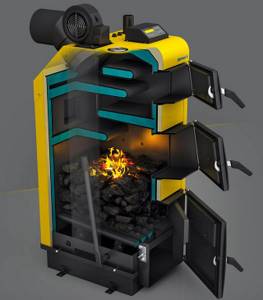
Getting the optimal result when burning coal depends on how correctly the technology of all stages of the combustion process is carried out, from loading firewood to replenishing the main fuel in the firebox. Success largely depends on how to light the boiler. The fact is that coal, anthracite or coke, enter the combustion process when the temperature in the combustion center reaches 400-600 degrees. It is simply impossible to achieve this with paper, and solid fuel itself will not be ignited by the fire of a match or a sheet of paper.
Preparing the stove for lighting
Before lighting a stove or boiler after a long period of inactivity, do the following:
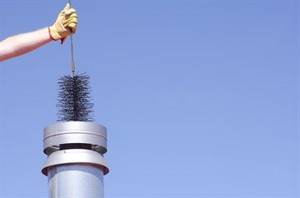
- inspect the firebox for cracks. Through them, poisonous carbon monoxide will enter the room. Found cracks are welded or covered with clay mortar (brick kiln);
- check the condition of the chimney. If there is debris or bird nests, the smoke exhaust duct should be cleaned. It is also necessary to remove soot: it narrows the chimney and can catch fire, which will lead to damage to the structure, and possibly a fire;
- clean the firebox from soot and wipe with a dry cloth;
- remove flammable objects and materials located near the heater away.
Now, if coal is available, the boiler can be heated.
The process of igniting a solid fuel heating boiler

The technology for igniting a solid fuel boiler is no different from the process of igniting a boiler with wood. There are just some nuances here. The first nuance is that a special grill for coal fuel must be installed in the lower part of the firebox. The purpose of this grate is that it allows the coals to be mixed during combustion. It is made in the form of a massive cast iron casting with a distance between the grates of 1.5-2 cm. This grate is installed vertically in the lower part of the firebox, and is closed by a blower door with a gate that regulates the oxygen supply.
Paper is placed in the lower part, on top of which wood chips are laid. The next layer includes splinters and small logs to ignite an active flame. 4-5 large logs are laid on top. The top layer is laid so that coal can be poured onto it, and at the same time, fuel does not spill into the blower.
For kindling, softwood chips are taken, it quickly flares up, maintaining combustion, creating sufficient temperature for the hardwood logs to ignite. Hardwoods are used as firewood - oak, birch, hornbeam; they create the necessary temperature to light the coal.
For the first laying, fine coal is used - with a diameter of 3-4 cm; the ideal option here would be gas coal or flammable coal.
It is important to remember that dry wood is used for ignition. Under no circumstances should flammable mixtures or liquid fuel be used. If you pour gasoline, biofuel or diesel into the firebox, there is a high probability that it will spill into the duct and even leak onto the floor. In this case, a fire cannot be avoided. It is better to put more crumpled paper at the bottom than to add even a drop of gasoline.
You can light a fire with a match or a lighter, there is no difference, the main thing is that the fire engulfs the wood chips and the top logs as quickly as possible.
Main combustion period
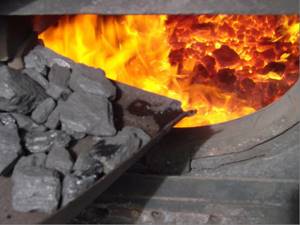
Conventionally, the process of how to properly heat a boiler with coal can be divided into several stages - the first ignition, the second period of main combustion, the stage of achieving stable combustion and finally, attenuation.
The main period of combustion usually occurs at the moment when the firewood forms productive coals for backfilling the stone fuel. How to properly heat a solid fuel boiler depends on when the moment of filling the first portion of fuel is chosen. In terms of time, from the moment the paper begins to burn until the logs of the main tree are engulfed in flames, it usually takes 4-5 minutes, but this is with normal draft and an open blower damper. You can check what is happening in the firebox by opening the firebox door - when opened carefully, the firebox will be illuminated with an even, bright flame, which means that the time has come to add the first portion of coal.
First, fine coal 2-4 cm in diameter is poured into the firebox. At approximately this stage you will need from 0.5 to 1 kg of fuel or 1-2 scoops. Coal is poured through the fire door and made so that its layer is evenly distributed over the entire fire area. Immediately after backfilling, the door closes, and the valve on the vent door opens slightly to increase the access of oxygen to the combustion space.
It’s worth checking what’s happening in the firebox after 10-12 minutes. This time is enough for the temperature to rise to 400 degrees and the fuel begins to burn, releasing enough heat. During this period, it is worth paying attention to the readings of the thermometer on the boiler; if the temperature rises sharply and the coolant begins to heat up better in the pipes and radiators, it means that it is time to supplement the boiler with another portion of fuel.
According to the rules of how to properly heat a boiler with coal, you need to add from 3 to 5 kg of anthracite or medium-fraction hard coal. The coals should be of average size 4-7 cm in diameter. Just like fuel, filling is done through the combustion door with a spatula or scoop. If possible, the coal is scattered over the entire area of the firebox so that the layer is about 10-15 cm (however, much depends on the size of the firebox). After the firebox door is closed, the thermostat is set and the boiler is switched to long-burning mode, when it itself regulates the opening and closing of the oxygen supply valve.
Stable combustion stage
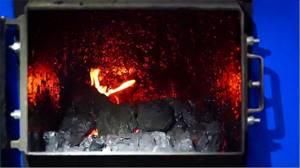
The stable combustion stage lasts about 5-9 hours. The main technique on how to properly heat a boiler during this period is to uniformly supply fuel to the firebox. Usually, if at the first filling ¼ of the fuel is used, then during the period of maintaining stable combustion, the remaining fuel is divided into 3 equal parts. After adding anthracite through the vent grate, the burning mass is stirred to prevent slagging of the firebox.
How to reduce fuel consumption?
There are several ways to reduce fuel consumption in a coal boiler:
- First of all, you need to use high-quality types of coal. They have greater heat transfer and therefore require less volume to heat the room.
- Over time, coal consumption increases due to clogging of the chimney and heat exchanger. To avoid this, preventive cleaning of the main equipment components is carried out every six months.
- Long-burning boiler models and pyrolysis devices consume less coal due to design features and more efficient use of combustible materials.
